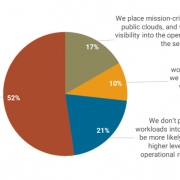Tier Certification for Modular and Phased Construction
Special care must be taken on modular and phased construction projects to avoid compromising reliability goals. Shared system coordination could defeat your Tier Certification objective
By Chris Brown
Today, we often see data center owners taking a modular or phased construction approach to reduce the costs of design, construction, and operation and build time. Taking a modular or phased construction approach allows companies to make a smaller initial investment and to delay some capital expenditures by scaling capacity with business growth.
The modular and phased construction approaches bring some challenges, including the need for multiple design drawings for each phase, potential interruption of regular operations and systems during expansion, and the logistics of installation and commissioning alongside a live production environment. Meticulous planning can minimize the risks of downtime or disruption to operations and enable a facility to achieve the same high level of performance and resilience as conventionally built data centers. In fact, with appropriate planning in the design stage and by aligning Tier Certification with the commissioning process for each construction phase, data center owners can simultaneously reap the business and operating benefits of phased construction along with the risk management and reliability validation benefits of Tier Certification Constructed Facility (TCCF).
DEFINING MODULAR AND PHASED CONSTRUCTION
The terms modular construction and phased construction, though sometimes used interchangeably, are distinct. Both terms refer to the emerging practice of building production capacity in increments over time based on expanded need.

Figure 1. Phased construction allows for the addition of IT capacity over but time but relies on infrastructure design to support each additional IT increment.
However, though all modular construction is by its nature phased, not all phased construction projects are modular. Uptime Institute classifies phased construction as any project in which critical capacity components are installed over time (see Figure 1). Such projects often include common distribution systems. Modular construction describes projects that add capacity in blocks over time, typically in repeated, sequential units, each with self-contained infrastructure sufficient to support the capacity of the expansion unit rather than accessing shared infrastructure (see Figure 2).

Figure 2. Modular design supports the IT capacity growth over time by allowing for separate and independent expansions of infrastructure.
For example, a phased construction facility might be built with adequate electrical distribution systems and wiring to support the ultimate intended design capacity, with additional power supply added as needed to support growing IT load. Similarly, cooling piping systems might be constructed for the entire facility at the outset of a project, with additional pumps or chiller units added later, all using a shared distribution system.

Figure 3. Simplified modular electrical system with each phase utilizing independent equipment and distribution systems
For modular facilities, the design may specify an entire electrical system module that encompasses all the engine-generator sets, uninterruptible power supply (UPS) capacities, and associated distribution systems needed to support a given IT load. Then, for each incremental increase in capacity, the design may call for adding another separate and independent electrical system module to support the IT load growth. These two modules would operate independently, without sharing distribution systems (see Figure 3). Taking this same approach, a design may specify a smaller chiller, pump, piping, and an air handler to support a given heat load. Then, as load increases, the design would include the addition of another small chiller, pump, piping, and air handler to support the incremental heat load growth instead of adding onto the existing chilled water or piping system. In both examples, the expansion increments do not share distribution systems and therefore are distinct modules (see Figure 4).

Figure 4. Simplified modular mechanical system with each phase utilizing independent equipment and distribution systems expansions of infrastructure.
CERTIFICATION IN A PHASED MODEL: DESIGN THROUGH CONSTRUCTION
Organizations desiring a Tier Certified data center must first obtain Tier Certification of Design Documents (TCDD). For phased construction projects, the Tier Certification process culminates with TCCF after construction. (For conventional data center projects the Tier Certification process culminates in Tier Certification of Operational Sustainability.) TCCF validates the facility Tier level as it has been built and commissioned. It is not uncommon for multiple infrastructure and/or system elements to be altered during construction, which is why Tier Certification does not end with TCDD; a facility must undergo TCCF to ensure that the facility was built and performs as designed, without any alterations that would compromise its reliability. This applies whether a conventional, phased, or modular construction approach is used.
In a phased construction project, planning for Tier Certification begins in the design stage. To receive TCDD, Uptime Institute will review each phase and all design documents from the initial build through the final construction phase to ensure compliance with Tier Standards. All phases should meet the requirements for the Tier objective.
Certification of each incremental phase of the design depends on meaningful changes to data center capacity, meaningful being the key concept. For example, upgrading a mechanical system may increase cooling capacity, but if it does not increase processing capacity, it is not a meaningful increment. An upgrade to mechanical and/or electrical systems that expands a facility’s overall processing capacity would be considered a meaningful change and necessitate that a facility have its Certification updated.
In some cases, organizations may not yet have fully defined long-term construction phases that would enable Certification of the ultimate facility. In these situations, Uptime Institute will review design documents for only those phases that are fully defined for Tier Certification specific to those phases. Tier Certification (Tier I-IV) is limited to that specific phase alone. Knowing the desired endpoint is important: if Phase 1 and 2 of a facility do not meet Tier criteria, but subsequently Phase 3 does; then, completion of a TCCF review must wait until Phase 3 is finished.
TCCF includes a site visit with live functional demonstrations of all critical systems, which is typically completed immediately following commissioning. For a phased construction project, Tier Certification of the Phase 1 facility can be the same as Tier Certification for conventional (non-phased) projects in virtually all respects. In both cases, there is no live load at the time, allowing infrastructure demonstrations to be performed easily without risking interruption to the production environment.

Figure 5. Simplified phased electrical system with each additional phase adding equipment while sharing distribution components
The process for Tier Certification of later phases can be as easy as it is for Phase 1 or more difficult, depending on the construction approach. Truly modular expansion designs minimize risk during later phases of commissioning and TCCF because they do not rely on shared distribution systems. Because modules consist of independent, discrete systems, installing additional capacity segments over time does not put facility-wide systems at risk. However, when there is shared infrastructure, as in phased (not modular) projects, commissioning and TCCF can be more complex. Installing new capacity components on top of shared distribution paths, e.g., adding or upgrading an engine generator or UPS module, requires that all testing and demonstrations be repeated across the whole system. It’s important to ensure that all of the system settings work together, for example, verifying that all circuit breaker settings remain appropriate for the new capacity load, so that the new production load will not trip the breakers.
Pre-planning for later phases can help ensure a smooth commissioning and Tier Certification process even with shared infrastructure. As long as the design phases support a Tier Certification objective, there is no reason why phased construction projects cannot be Tier Certified.
COMMISSIONING AND TIER CERTIFICATION
TCCF demonstrations align with commissioning; both must be completed at the same stage (following installation, prior to live load). If a data center design allows full commissioning to be completed at each phase of construction, Tier Certification is achievable for both modular and non-modular phased projects. TCCF demonstrations would be done at the same expansion stages designated for the TCDD at the outset of the project.
For a modular installation, commissioning and Tier Certification demonstrations can be conducted as normal using load banks inside a common data hall, with relatively low risk. If not managed properly, load banks can direct hot air at server intakes, which would be the only significant risk. Obviously this risk can be prevented.
For phased installations that share infrastructure, later phases of commissioning and Tier Certification carry increased risk, because load banks are running in common data halls with shared distribution paths and capacity systems that are supporting a concurrent live load. The best way to reduce the risks of later phase commissioning and Tier Certification is to conduct demonstrations as early in the Certification as possible.

Figure 6. Simplified phased mechanical system with each additional phase adding equipment while sharing distribution components
Shared critical infrastructure distribution systems included in the initial phase of construction can be commissioned and Tier Certified at full (planned) capacity during the initial TCCF review, so these demonstrations can be front loaded and will not need to be repeated at future expansion phases.
The case studies offer examples of how two data centers approached the process of incorporating phased construction practices without sacrificing Tier Certification vital to supporting their business and operating objectives.
CONCLUSION
Modular and phased construction approaches can be less expensive at each phase and require less up-front capital than traditional construction, but installing equipment that is outside of that specified for the TCDD or beyond the capacity of the TCCF demonstrations puts not only the Tier Certification at risk, but the entire operation. Tier Certification remains valid only until there has been a change to the infrastructure. Beyond that, regardless of an organization’s Tier objective, if construction phases are designed and built in a manner that prevents effective commissioning, then there are greater problems than the status of Tier Certification.
A data center that cannot be commissioned at the completion of a phase incurs increased risk of downtime or system error for that phase of operation and all later phases. Successful commissioning and Tier Certification of phased or modular projects requires thinking through the business and operational impacts of the design philosophy and the decisions made regarding facility expansion strategies. Design decisions must be made with an understanding of which factors are and are not consistent with achieving the Tier Certificationthese are essentially the same factors that allow commissioning. In cases where a facility expansion or system upgrade cannot be Tier Certified, Uptime Institute often sees that is usually the result of limitations inherent in the design of the facility or due to business choices that were made long before.
It is incumbent upon organizations to think through not only the business rationale but also the potential operational impacts of various design and construction choices. Organizations can simultaneously protect their data center investment and achieve the Tier Certification level that supports the business and operating missionincluding modular and phased construction plans by properly anticipating the need for commissioning in Phase 2 and beyond.
Planning design and construction activities to allow for commissioning greatly reduces the organization¹s overall risk. TCCF is the formal validation of the reliability of the built facility.
Case Study: Tier III Certification of Constructed Facility: Phased Construction
An organization planned a South African Tier III facility capital infrastructure project in two build phases, with a shared infrastructure (i.e., non-modular, phased construction). The original design drawings specified two chilled-water plants: an air-cooled chiller plant and an absorption chiller plant, although, the absorption chiller plant was not installed initially due to a limited natural gas supply. The chilled-water system piping was installed up front, and connected to the air-cooled chiller plant. Two air-cooled chillers capable of supporting the facility load were then installed.
The organization installed all the data hall air-handling units (AHUs), including two Kyoto Cooling AHUs, on day one. Because the Kyoto AHUs would be very difficult to install once the facility was built, the facility was essentially designed around them. In other words, it was more cost effective to install both AHUs during the initial construction phase, even if their full capacity would not be reached until after Phase 2.
The facility design utilizes a common infrastructure with a single data hall. Phase 1 called for installing 154 kilowatts (kW) of IT capacity; an additional 306 kW of capacity would be added in Phase 2 for a total planned capacity of 460 kW. Phase 1 TCCF demonstrations were conducted first for the 154 kW of IT load that the facility would be supporting initially. In order to minimize the risk to IT assets when Phase 2 TCCF demonstrations are performed, the commissioning team next demonstrated both AHUs at full capacity. They increased the loading on the data hall to a full 460 kW, successfully demonstrating that the AHUs could support that load in accordance with Tier III requirements.
For Tier Certification of Phase 2, the facility will have to demonstrate that the overall chilled water piping system and additional electrical systems would support the full 460-kW capacity, but they will not have to demonstrate the AHUs again. During Phase 1 demonstrations, the chillers and engine generators ran at N capacity (both units operating) to provide ample power and cooling to show that the AHUs could support 460 kW in a Concurrently Maintainable manner. The Phase 2 demonstrations will not require placing extra load on the UPS, but they did test the effects of putting more load into the data hall and possibly raising the temperature for the systems under live load.
Case Study: Tier III Expanded to Tier IV
The design for a U.S.-based cloud data center validated as a Tier III Certified Constructed Facility after the first construction phase calls for a second construction phase and relies on a common infrastructure (i.e., non-modular, phased construction). The ultimate business objective for the facility is Tier IV, and the facility design supports those objectives. The organization was reluctant to make expenditures on the mechanical UPS required to provide Continuous Cooling for the full capacity of the center until it had secured a client that required Tier IV performance, which would then justify the capital investment in increasing cooling capacity.
The organization was only able to achieve this staged Tier expansion because it worked with Uptime Institute consultants to plan both phases and the Tier demonstrations. For Phase 1, the organization installed all systems and infrastructure needed to support a Tier IV operation, except for the mechanical UPS, thus the Tier Certification objective for Phase 1 was to attain Tier III. Phase 1 Tier Certification included all of the required demonstrations normally conducted to validate Tier III, with load banks located in the data hall. Additionally, because all systems except for the mechanical UPS were already installed, Uptime Institute was able to observe all of the demonstrations that would normally be required for Tier IV TCCF, with the exception of Continuous Cooling.
As a result when the facility is ready to proceed with the Phase 2 expansion, the only demonstrations required to qualify for Tier IV TCCF will be Continuous Cooling. The organization will have to locate load banks within the data hall but will not be required to power those load banks from the IT UPS nor simulate faults on the IT UPS system because that capability has already been satisfactorily observed. Thus, the organization can avoid any risk of interruption to the live customer load the facility will have in place during Phase 2.
The Tier III Certification of Constructed Facility demonstrations require Concurrent Maintainability. The data center must be able to provide baseline power and cooling capacity in each and every maintenance configuration required to operate and maintain the site for an indefinite period. The topology and procedures to isolate each and every component for maintenance, repair, or replacement without affecting the baseline power and cooling capacity in the computer rooms should be in place, with a summary load of 750 kW of critical IT load spread across the data hall. All other house and infrastructure loads required to sustain the baseline load must also be supported in parallel with, and without affecting, the baseline computer room load.
Tier Certification requirements are cumulative; Tier IV encompasses Concurrent Maintainability, with the additional requirements of Fault Tolerance and Continuous Cooling. To demonstrate Fault Tolerance, a facility must have the systems and redundancy in place so that a single failure of a capacity system, capacity component, or distribution element will not impact the IT equipment. The organization must demonstrate that the system automatically responds to a failure to prevent further impact to the site operations. Assessing Continuous Cooling capabilities require demonstrations of computer room air conditioning (CRAC) units under various conditions and simulated fault situations.
Christopher Brown joined Uptime Institute in 2010 and currently serves as Vice President, Global Standards and is the Global Tier Authority. He manages the technical standards for which Uptime Institute delivers services and ensures the technical delivery staff is properly trained and prepared to deliver the services. Mr. Brown continues to actively participate in the technical services delivery including Tier Certifications, site infrastructure audits, and custom strategic-level consulting engagements.










